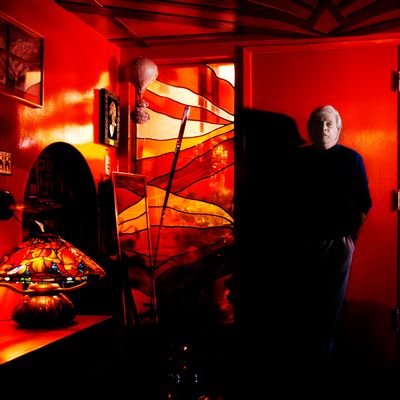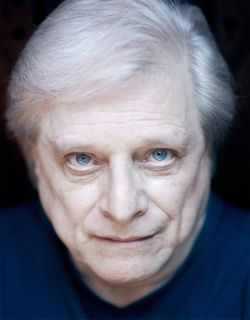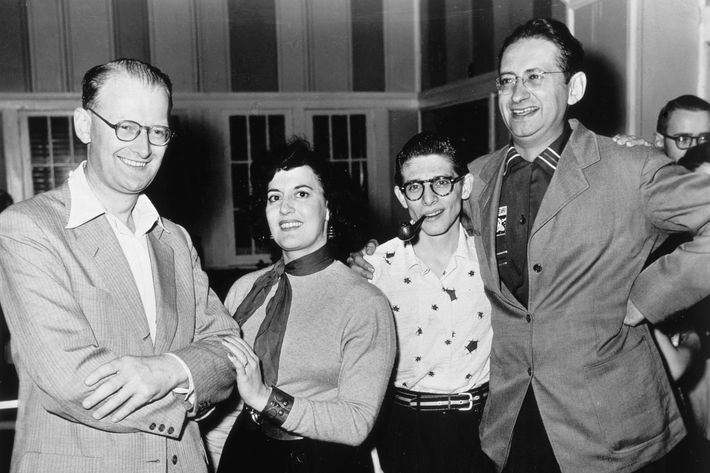
Two and a half years ago, I called Harlan Ellison because I’d heard through a family friend that he was dying. Well, I heard it through a family friend and because he announced it to an audience of fans at a science-fiction convention in Wisconsin. When I spoke with the legendary – and legendarily combatitive – sci-fi writer on the phone shortly afterwards, his voice was weak. You’d better come by soon, he said. I did, and with a tray full of noodle kugle that my mom made for him and for his wife, Susan.
“This is what happened. When I was in Madison, this guy in the audience kept going after me. And finally I had to say, ‘What part of I’m dying don’t you get?’ I’m dying, I can feel it.” Ellison told me this while he was standing next to his desk, an area Scotch-taped to hell with quotes, phrases, sayings, and instructional words. The most prominent taped to his typewriter was: “I’m an artist; and should be exempt from shit.” Ellison said then, “It’s astonishing to me, with the life that I’ve led, that I’ve made it this long. I should have been bumped off or wound up in jail or been a bum. I don’t want my friends to see me under the weather. They’ve seen me ebullient, they’ve seen me buoyant — really up — and to come in and see an old man who can’t get out of bed … I can’t get out of bed … ” His voice trailed off.
In spite of his dire warnings, Ellison is alive and well and living in Los Angeles. This week he is releasing his first book-length work in almost a decade: 7 Against Chaos, a graphic novel from DC Comics. It is a vision of a future on the verge of apocalypse, but saved by a dream team of oddballs and freaks of nature that pick a fight with a monomaniacal lizard who rules an alternate universe. Ellison, never one to shy away from hyperbole, says of the book, “I hope it will leave a giant footprint on the arid plain of my life. This book is something — as I get closer to the edge of the abyss — I’m enormously proud of. It’s my Lawrence of Arabia, my Gone With the Wind.” He told me this recently on the phone, shortly after recording a guest spot on The Simpsons. (When he got the call requesting his cameo, Ellison’s response was: “Well, it’s about goddamn time.”) He did his spot in one take (his version of events), then joined the Simpsons’ writers and assorted crew for lunch. Producer and showrunner Al Jean had described it to me like this: “We had lunch with Harlan afterwards, where he was brilliant, hilarious and unprintable.”
For the next two and half years — until the last few months, in fact — Ellison’s voice remained flat-sounding when I called to check in on him from time to time. “Not now, I can’t talk now,” he would say, and then futz with his rotary phone until the line would go dead. In those moments, he sounded like he really was dying. But talking to him now, there is a familiar perk to his gravelly tone, a feistiness that has returned.
Part of the reason he’s been feeling better, he told me, was that he had finally managed to get back to work and complete 7 Against Chaos. The fact that it was a collaborative project was a huge help. “I’ve always been a solo act, my own dog and pony show and one develops a hubris,” he said. “But with 7 Against Chaos, there were three of us working on it and Paul Chadwick and Ken Steacy kept me on top of it.” When Ellison sold the project — for years in development purgatory as movie — to DC Comics as a graphic novel, he requested two top-shelf creative partners: artist Chadwick of Concrete fame and legendary colorist Steacy. Both signed on to the project simply because Ellison was involved.
Like most superheroes, the main characters in 7 Against Chaos, a ragtag gang trying to save reality as we know it, have severe abnormalities that they have turned into unique powers. There’s Mourna, a stunning, seven-foot-tall Amazon with metallic claws instead of hands; Tantalus, a human-size praying mantis; Hoorn, a thief with no face; and Urr, a robot who has rebelled against his human programmers. Chadwick described it as a story about “misfits doing, reluctantly, the noble thing.”

I’ve always thought Ellison’s curmudgeon veneer was shtick. I met him when I was 3: My mom dated him for a couple of weeks in the late seventies. One night my brother and I went to visit him at his home. My brother, who was 5, had walking pneumonia and was coughing all over the multi-level clubhouse that Ellison had built and lived in. There were midget doors, secret passageways, hiding places, and books — walls and walls of moveable library stacks. I remember clearly Ellison’s booming voice and his insistence that my brother go outside to cough. Ellison was wildly animated, a human cartoon, playfully badgering us to the point of hysteria. All we could do was laugh, which meant more coughing from my brother, more trips to the patio.
The man leaves a lasting impression. Faulkner said that the essence of writing is “the heart in conflict with itself” — and Ellison is in conflict with everything. That famous contentiousness has come, in some ways, to overshadow and define the work he has put down on the page. There’s no doubt that he’s an immensely productive writer, having churned out over 1,800 stories, novels, screenplays, teleplays and essays in a 57-year writing career that began during his youth in Cleveland. Ellison has enjoyed cult-hero status for decades and collected a vast array of awards including ten Hugos (the Oscars of the sci-fi world) and, in more recent years, two Grammy nominations for spoken-word recordings. Trekkies will argue that the episode of the original Star Trek series he wrote, “City on the Edge of Forever,” was perhaps the best one ever aired. Both as a writer and an editor of two highly influential anthologies, he is rightly credited as a pioneer in the new wave of science fiction that took over the genre in the late sixties as the field became more literary, socially conscious, and less focused on adventure at the limits of the scientifically possible. Ellison’s best works — including “Deathbird Stories,” “I Have No Mouth and I Must Scream,” “Love Ain’t Nothing But Sex Misspelled,” “Ellison Wonderland,” and “Stalking the Nightmare” — are finely tuned contemporary parables. There is always a moral lesson, always high ground. His prose is energetic (wild, some might say) and unguarded. He wrote one of his most haunting short stories “Pretty Maggie Moneyeyes” in the nude, because inspiration struck and he was worried it might escape him if he took the time to get dressed. Typically, his fiction demands a suspension of disbelief — in “Moneyeyes” a prostitute’s soul becomes trapped in a slot machine — even as the main ideas are firmly grounded in a very familiar social reality.
But despite the fact — perhaps because of the fact? — that he’s science-fiction legend, Ellison peevishly rejects the genre. “Call me a science-fiction writer and I will come to your house and nail your dog’s head to the coffee table!” he said.
This, of course, is both innate to who he is — and part of the shtick. “I have a reputation for being churlish,” Ellison told me. “I’m not a liberal, I’m not a conservative, I’m nothing. I’m a pain in the ass — that’s my job.” The job description includes filing reams of lawsuits, including a famous one against James Cameron for stealing the idea for The Terminator from two scripts Ellison wrote for Outer Limits, a sixties television show. He has sued AOL and more than 240 other people who have distributed his writings on the Internet without permission.
Ellison’s most famous scene is one he didn’t write. It was late one night in 1965 at the Daisy, a club in Beverly Hills. Omar Sharif, Leo Durocher, Peter Falk, and Ellison were shooting pool when the crowd parted dramatically to make way for Frank Sinatra. What happened next is chronicled in Gay Talese’s canonical article for Esquire, “Frank Sinatra Has a Cold.” In one of the more memorable sections of the piece, Sinatra entered the bar and noticed that the virtually unknown young writer was wearing a rather flamboyant pair of boots. The singer began giving him grief. Ellison was having none of it:
Harlan Ellison moved a step to the side. “Look, is there any reason why you’re talking to me?”
“I don’t like the way you’re dressed,” Sinatra said.
“Hate to shake you up,” Ellison said, “but I dress to suit myself.”
The conflict escalated until the two men were standing nose-to-nose, each refusing to back down. Talese summed up the moment with this immortal line: “Sinatra probably forgot about it at once, but Ellison will remember it all his life.”
For his part, Ellison had no idea that encounter was being documented until a week later, when Talese sought him out to get his side of the story. “I played it down. I said, ‘Eh, no big deal, I think [Sinatra] had a little too much to drink.’ He says, ‘Tell me what happened.’ Well, I’m talking to Gay Talese — if he had told me to recite the first three volumes of the encyclopedia backwards, I’d have done it, ‘cause Gay Talese was as close to the top of the mountain as I could think of anybody getting.”
When I visited Ellison at his home, he showed me the boots, perfectly preserved in a plastic bag that hangs in his closet. “They’re gorgeous,” he said. “I was wearing light brown corduroy pants tucked all the way in and I was wearing a brown suede shirt, very Robin Hood–y with laces that went up the chest … very Carnaby Street. I thought I looked very cool. I was getting laid regularly, and Frank Sinatra started in on me and it got very complex.” The article makes the confrontation sound like so much macho posturing, an aging crooner challenging and challenged by an outspoken upstart. But according to Harlan and Talese, there was more subtext to the confrontation. Says Talese, today: “The rumor of having Mafia connections, the sense of omnipotence Sinatra had and the fact that he was volatile – well, everyone seemed concerned except for this crazy little guy I had never heard of. Given the time, Sinatra could ruin your career, he had power. He could ruin your livelihood if he was vindictive enough. Ellison was vulnerable.”
Ellison survived Sinatra. He’s survived a lot — endless feuds, four broken marriages, quadruple bypass surgery. In 2010, shortly after he made the I’m-dying announcement to the science-fiction convention, he suffered a sudden and severe weight loss. It landed him in the hospital, and he told friends and relatives that this was the end.
He didn’t die, but it was far from a pleasant stay. “They put me in the hospital and I was going crazy,” he told me. “You take someone who is tense, uptight, nervous, and anxious — and they put me in a little room. So, I broke loose, I pulled all the needles out; I signed myself out and went running down the hall in those little blue booties.” He speaks shakily about the episode at Cedars-Sinai Hospital. “Kid, they gave me all kinds of meds, but they don’t know what the hell it is.” But, in a sense, they did. He had been walloped by a devastating bout of depression. As he described it to me, it sounded disorienting, debilitating, and thoroughly horrible — perhaps all the more so because he clearly never imagined himself as a person who might be vulnerable to such a thing. So was he really dying? Let it suffice to say that Ellison very much believed himself to be on the edge of death, and in the worst moments of mental illness those two things are not that far apart.
But if you’re going to be laid up in bed, as Ellison has been on and off for the past couple years, his home in just off Mulholland Drive isn’t a bad place for it. His house is not unlike his personality: a curio wrapped in razor wire. The façade — created by the same designer responsible for the Abominable Snowman in Disneyland’s Matterhorn ride — includes a secret rotating message spelled out in glyphs and translated at the front door. Today’s: “There are some places in this Universe that can only be seen with the eye of the imagination. This is one of them.” Inside, the walls are lined with collections and trinkets and framed articles and stacks of paper and tea pots and action figures. As his friend the actor and comedian Robin Williams told me, “Harlan’s the keeper of the knowledge and the sacred tchotchkes.”
Ellison and his wife Susan are constantly shouting warnings: “Watch your step!”; “Be careful!”; “I’ll give you a hand, you might impale yourself on this Jiminy Cricket pencil sharpener.” The house, guarded by six protective gargoyles at the entrance, one with the face of Nixon, another modeled after J. Edgar Hoover, looks out on an undeveloped hillside that Ellison lobbied successfully with Leonard Nimoy to protect.
In all the collections, manuscripts, toys, and pep pins, there is a map of a man’s life. Harlan was born in Painesville, Ohio, to adoring parents in 1934. “It was very clear to me from the beginning that my parents, well, it was as if a pair of pandas had given birth to a cheetah.” After a restless youth in Cleveland, he moved to New York in 1955 and then to L.A. in 1962. He still does all his writing on a manual typewriter and any e-mail correspondence goes through his wife, Susan. He has no children with her or from any of his four previous marriages.

Ellison’s true and absolute devotion has always been to the process of writing. “You have to want to create so badly that nothing else matters. Because, dig it, in the final analysis, when you are worm food, all that will be left, that anyone’ll ever know is what you were able to set down on paper,” he said in a 1973 lecture at the American Film Institute.
Sitting in his kitchen playing gin rummy with worn Magic Castle cards (he won every game, despite the fact that he was “dying”), he tried to describe how he defines his characters on the page. He told a long and impassioned story about someone he knew who went to a Chinese restaurant in New York to pick up a takeout order and spotted a rat scampering across the floor. “He just took the bags and walked out and left the little guy standing there with none of the food paid for,” he said. “That’s a low motherfucker. That’s a person whose core is black. You don’t do that. Now if I write a story and need to give you that guy’s character, I would just give you that.”
A couple of days after our card game, Ellison called to tell me he couldn’t get out of bed. His voice was thin. Still, he invited me to the house and I spent the day with his longtime assistant, Sharon, paging through tabloid-size scrapbooks — there were easily fifteen volumes cataloguing every printed mention of him. There was a newspaper clipping of his arrest for violating a weapons law when police found brass knuckles, a loaded revolver, a dagger, and a switch-blade knife in his apartment, all left over from his participatory account of hanging out with the Red Hook Brooklyn Barons street gang (republished last year in a Kicks Books anthology). There were clippings documenting feminist outrage at the movie version of Ellison’s short story “A Boy and His Dog,” starring Don Johnson. Pictures of young handsome Ellison, almost always in mid-proclamation and dressed in outfits that would make Stevie Wonder blush, were in no short supply. And, of course, the artifacts of rage past: red sticker dots blotting out the face of the author Forrest Ackerman for indeterminate grievances; a Western Union Telegram from October 16, 1967, reading, “May 10,000 Mongrel Dragons rip from your opulent structure that niggardly portion which is your heart and feed upon its rock hard substance while stamping your accursed soul to dust. Luv, Bunny.”
Toward the end of the day, Ellison boomed over the intercom like the voice of God: “It’s cold up there. You guys have been at it for hours. End it.”
Endings remain very much on his mind. “I have led what others call the good life,” he said on the phone a few weeks ago. “I’ve done what I love all my life and I’m still doing it. Working hard is the only thing I know.” Work is still what sustains him, even if it means he now has to be part of a team to finish anything big, as was the case with 7 Against Chaos. He has also decided what he wants on his tombstone, whenever it might happen to be inscribed: “For a while I was here and for a while I mattered.”




